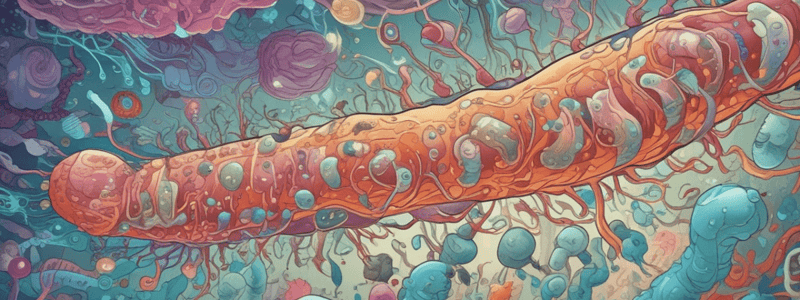Podcast
Questions and Answers
Bacteria are multi-celled microorganisms that can only be found in extreme environments.
Bacteria are multi-celled microorganisms that can only be found in extreme environments.
False (B)
Fungi can produce enzymes that help them digest organic matter.
Fungi can produce enzymes that help them digest organic matter.
True (A)
Viruses can replicate independently without the need for a host cell.
Viruses can replicate independently without the need for a host cell.
False (B)
Both bacteria and fungi can be harmful to humans.
Both bacteria and fungi can be harmful to humans.
Signup and view all the answers
The structure that fungi form is known as mycelia and fruiting bodies.
The structure that fungi form is known as mycelia and fruiting bodies.
Signup and view all the answers
Bacteria play no significant roles in ecosystems.
Bacteria play no significant roles in ecosystems.
Signup and view all the answers
Viruses are larger than bacteria and can be seen with the naked eye.
Viruses are larger than bacteria and can be seen with the naked eye.
Signup and view all the answers
Fungi are prokaryotic organisms distinct from animals and bacteria.
Fungi are prokaryotic organisms distinct from animals and bacteria.
Signup and view all the answers
New viruses are regularly discovered due to their vast diversity.
New viruses are regularly discovered due to their vast diversity.
Signup and view all the answers
Study Notes
Bacteria
- Exist in diverse shapes, sizes, and functions, and can be found in almost every environment on Earth, including extreme conditions.
- Play crucial roles in ecosystems, including decomposing organic matter, nitrogen fixation, and symbiotic relationships with plants and animals.
- Some bacteria are harmful to humans, causing diseases such as tuberculosis, cholera, and pneumonia.
Fungi
- Are eukaryotic organisms, distinct from plants, animals, and bacteria, characterized by their ability to digest organic matter, produce enzymes, and form complex structures like mycelia and fruiting bodies.
- Can be found in almost every habitat, including soil, water, and air.
- Play essential roles in nutrient cycling, decomposition, and as symbionts with plants.
- Some fungi are harmful to humans, causing diseases like athlete's foot and yeast infections.
Viruses
- Are the smallest known infectious agents, consisting of a piece of genetic material (DNA or RNA) surrounded by a protein coat.
- Cannot replicate on their own and rely on host cells to reproduce.
- Infect all types of living organisms, including bacteria, archaea, plants, and animals.
- Can cause diseases ranging from the common cold to more severe illnesses like HIV/AIDS and Ebola.
- The diversity of viruses is vast, with new ones being discovered regularly.
Studying That Suits You
Use AI to generate personalized quizzes and flashcards to suit your learning preferences.
Related Documents
Description
Learn about the diversity of bacteria, their shapes, sizes, and functions, as well as their importance in ecosystems and their impact on human health.



